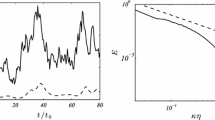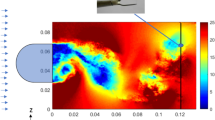Abstract
A study of some aspects of tracer particle responses to step changes in fluid velocity is presented. The effect of size distribution within a seed material on measured relaxation time is examined, with polydisperse particles of the same median diameter shown to possess a significantly higher relaxation time than their monodisperse counterparts when measured via a particle image velocimetry algorithm. The influence of a shock wave–induced velocity gradient within a PIV interrogation window on the correlation function is also examined using the noiseless cross-correlation function of Soria (Turbulence and coherent structures in fluids, plasmas and nonlinear media. World Scientific, Singapore, 2006). The presence of a shock is shown to introduce an artificial fluctuation into the measurement of velocity. This fluctuation is a function of the shock position, shock strength, spatial ratio and particle distribution. When the shock is located at the middle of the window, the magnitude of the fluctuation increases monotonically with increasing spatial ratio, increases asymptotically with shock strength, and decreases for increasing particle polydispersity. When the shock is located at the left-hand edge of the window, the magnitude of the artificial fluctuation is highest for intermediate spatial ratios, going to zero at infinitely high and low values. In this instance, particle polydispersity acts to increase the magnitude of fluctuations in measured velocity. In both cases, particle polydispersity serves to broaden the PDF of measured velocity. For the cases presented herein, with a shock located within the interrogation window, the root mean square of the artificial velocity fluctuations reaches values in excess of 30% of the freestream velocity.
















Similar content being viewed by others
References
Elsinga GE, van Oudheusden BW, Scarano F (2005) Evaluation of aero-optical distortion effects in PIV. Exp Fluids 39:246–256
Kahler CJ (1995) Generation and control of tracer particles for optical flow investigations in air. Exp Fluids 33:736–742
Krothapalli A, Rajkuperan E, Alvi F, Lourenco L (1999) Flow field and noise characteristics of a supersonic impinging jet. J Fluid Mech 392:155–181
Melling A (1997) Tracer particles and seeding for particle image velocimetry. Meas Sci Technol 8:1406–1416
Meyers J (1991) Generation of particles and seeding. In: Laser velocimetry, vol 8. von Karman Institute for Fluid Dynamics, pp 1–41
Meyers J, Feller W (1975) Development of a controllable particle generator for lv seeding in hypersonic wind tunnels. In: Minnesota Symposium on Laser Anemometry
Mitchell D, Honnery D, Soria J (2007a) High resolution measurements of an underexpanded supersonic jet. In: 7th International Symposium on Particle Image Velocimetry, Rome, Italy
Mitchell D, Honnery D, Soria J (2007b) Study of underexpanded supersonic jets with optical techniques. In: 16th Australiasian Fluid Mechanics Conference, Queensland, Australia
Mitchell D, Honnery D, Soria J (2009) The influence of shockwave induced velocity gradients on the correlation function. In: 8th International Symposium on Particle Image Velocimetry
Ragni D, Schrijer F, van Oudheusden B, Scarano F (2011) Particle tracer response across shocks measured by PIV. Exp Fluids 50:53–64
Rumpf H (1990) Particle technology. Chapman and Hall, London
Scarano F (2002) Iterative image deformation methods in PIV. Meas Sci Technol 13:R1–R19
Soria J (1996) An investigation of the near wake of a circular cylinder using a video-based digital cross-correlation particle image velocimetry technique. Exp Thermal Fluid Sci 12:221–233
Soria J (2006) Particle image velocimetry-application to turbulence studies. In: Turbulence and coherent structures in fluids, plasmas and nonlinear media. World Scientific, Singapore, pp 319–330
Stokes G (1851) On the effect of the internal friction of fluids on the motion of pendulums. Trans Cambridge Philos Soc 9:8–27
Tedeschi G, Gouin H (1999) Motion of tracer particles in supersonic flows. Exp Fluids 26:288–296
Urban WD, Mungal G (2001) Planar velocity measurements in compressible mixing layers. J Fluid Mech 431:189–222
Voges M, Klinner J, Willert C, Beversdorff M, Schodl R (2007) Assessment of powder-based seeding materials for piv applications in transonic, supersonic and reacting flows. In: 7th International Symposium on Particle Image Velocimetry, Rome, Italy
Westerweel J (2007) On velocity gradients in PIV interrogation. In: 7th International Symposium on Particle Image Velocimetry, Rome, Italy
Westerweel J, Dabiri D, Gharib M (1997) The effect of a discrete window offset on the accuracy of cross-correlation analysis of digital piv recordings. Exp Fluids 23:20–28
Xu J, Lin C, Sha J, Zhang K (2006) A PIV study and numerical simulation of overexpanded supersonic impinging free jet. In: 14th AIAA/AHI International Space Planes and Hypersonics Systems Conference, Canberra, Australia
Yao W, Guangsheng G, Fei W, Jun W (2002) Fluidization and agglomerate structure of SiO2 nanoparticles. Powder Technol 124:152–159
Acknowledgments
The authors would like to acknowledge the support of the Australian Research Council. The first author would also like to acknowledge the support received via the Australian Postgraduate Award.
Author information
Authors and Affiliations
Corresponding author
Rights and permissions
About this article
Cite this article
Mitchell, D., Honnery, D. & Soria, J. Particle relaxation and its influence on the particle image velocimetry cross-correlation function. Exp Fluids 51, 933–947 (2011). https://doi.org/10.1007/s00348-011-1116-0
Received:
Revised:
Accepted:
Published:
Issue Date:
DOI: https://doi.org/10.1007/s00348-011-1116-0




